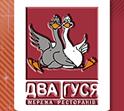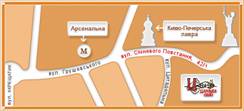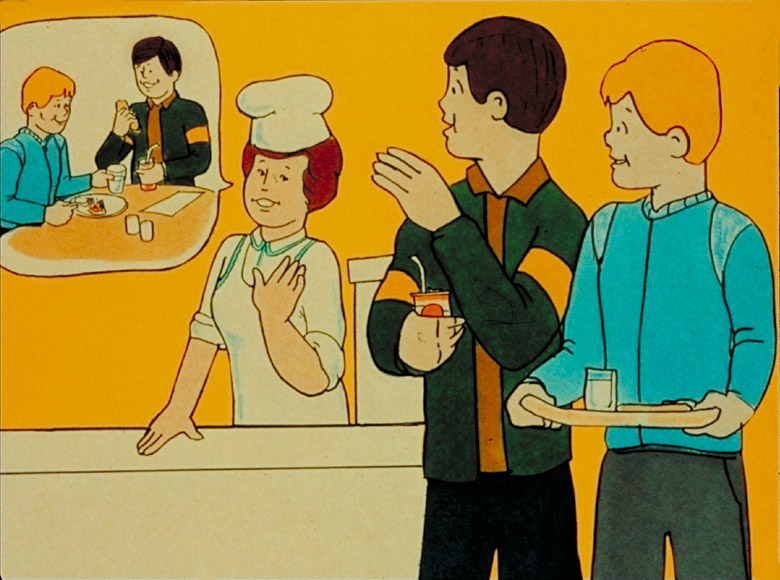
In this lesson you will:
a) learn vocabulary and phrases commonly used in cafeterias, cafes and restaurants.
b) compare dining experiences in North America and Ukraine.
c) reinforce your knowledge of country names and nationalities (Canada – Canadian, America (USA) – American, etc., ).
 Їмо у ресторані! Їмо у ресторані!
Some nouns related to the Unit theme are presented below. Most of the words are familiar to you: кухар/кухарка (cook), ковбаска (sausage), булочка (bun), піца (pizza), меню (menu), молоко (milk), сік (juice).
Recall that borrowed words, such as the neuter noun меню (menu), are usually not declined (an exception to this rule is піца). Also note that, to most Canadian speakers of Ukrainian, the phrase ковбаска на булочці means ‘hot dog’.
 |
У розмові ми чули: |
|
Що нового в меню сьогодні? |
 |
|
|
Але я бачу нову кухарку! |
 |
|
|
Ковбаску на булочці/з булочкою. |
 |
|
|
А я замовлю піцу. |
 |
|
|
Будь ласка, дайте молока! |
 |
|
|
А мені дайте соку! |
 |
|
 Cultural Notes Cultural Notes
When ordering in a café, cafeteria or restaurant, most people begin by studying the menu carefully and asking questions of the server or waiter. When visiting another country, however, there are often cultural norms which create a different experience while dining! The type of food on the menu, the order in which it is presented, and the time allotted for the entire meal will add a new and interesting dimension to your dining experience.
To illustrate some cultural differences between a menu from Ukraine and a North American menu, two samples are given below.
North American menu
Закуски - Appetizers /Hors d’oeuvres
Суп* - Soup
Салати - Salad
Страви - Entrée, Main Course
Десерти - Desserts
Напитки - Beverages
*Зупa – this term is more commonly used among Canadian speakers of Ukrainian |
Український меню
Холодні закуски – Hors d’oeuvres (served cold, as the name indicates)
Гарячі закуски – Hot appetizers
Перші страви – Soups (which are the ‘first course’)
Другі страви – Entrees (which are the ‘second course’)
Гарніри - Side dishes
Салати - Salads
Десерти - Desserts
Напої – Beverages |
By the length of the Ukrainian menu, it is not difficult to understand why an entire evening should be devoted to a ‘dining experience' in a Ukrainian restaurant. Food, carefully prepared with fresh ingredients, is meant to be savoured and enjoyed.
XXV. Exercise 2.i
In the exercise below you are asked to go to the link of two Ukrainian restaurants by clicking on the image. The first is a family-style restaurant, while the second is for fine dining. Study the menu of your choice (use your dictionary if needed) and write down which dishes you would choose for supper.
Два гуся (Київ)
 |
Царське село (Київ)
 |
Моя вечеря у ресторані: _____________________________
Закуски: ___________________________________________
Перша страва: ______________________________________
Друга страва: _______________________________________
Гарніри: ___________________________________________
Салати: ___________________________________________
Десерти: __________________________________________
Напої: ___________________________________________
Helpful Restaurant Vocabulary
 Офіціянт: Офіціянт:
Вам можна допомогти? Can I help you?
Чи ви замовили столик? Did you reserve a table?
Ви готові замовляти? Are you ready to order?
Що ви будете пити? What will you drink?
Ви будете їсти десерт? Will you eat a dessert?
Який гарнір ви хочете? What side dish will you have?
Чи все добре? Is everything OK?
Вам сподобалася вечеря? Did you like your supper?
Спробуйтенашфірменнийсалат. Try our house salad.
 Клієнт: Клієнт:
Можна столик для двох? May I/we have a table for two?
Що сьогодні у меню? What’s on the menu today?
Ваша риба/курка смажена чи печена? Is your fish/chicken fried or grilled?
Під томатним чи сметанним соусом? With tomato or cream sauce?
Що ви рекомендуєте? What do you recommend?
Ні, ми ще не готові. No, we are not ready yet.
Принесіть кетчуп, будь-ласка. Bring ketchup, please.
Я сьогодні плачý. I am paying today.
Принесіть, будь-ласка, рахунок. Bring the bill, please.
Я залишу ‘на чай’. I’ll leave the tip (literal meaning ‘for tea’)
XXV. Exercise 2.ii
Розмова у ресторані

Create a short dialogue in a restaurant, using some of the phrases given above.
___________________________________________________________________
___________________________________________________________________
___________________________________________________________________
___________________________________________________________________
___________________________________________________________________
___________________________________________________________________
___________________________________________________________________
 Люди – Країни Люди – Країни
In order to talk about ethnic cuisine in different countries, let's review what we know about countries of the world and the people who live there.
XXV. Exercise 2.iii
Match the Ukrainian nouns which you learned in previous course material with their English counterparts:
| 1. Австралія |
_____ Mexico |
| 2. Англія |
_____ England |
| 3. Болгарія |
_____ Japan |
| 4. Бразилія |
_____ India |
| 5. Греція |
_____ Russia |
| 6. Ізраїль |
_____ France |
| 7. Індія |
_____ Australia |
| 8. Ірак |
_____ Germany |
| 9. Iран |
_____ Bulgaria |
| 10. Ірляндія |
__22_ Ukraine |
| 11. Іспанія |
_____ Spain |
| 12. Італія |
_____ Poland |
| 13. Канада |
_____ Greece |
| 14. Китай |
_____ Turkey |
| 15. Мексика |
_____ Brazil |
| 16. Німеччина |
_____ Iraq |
| 17. Корея |
_____ China |
| 18. Польща |
_____ Italy |
| 19. Росія |
_____ Israel |
| 20. США |
_____ Korea |
| 21. Туреччина |
_____ Ireland |
| 22. Україна |
_____ U.S.A. |
| 23. Франція |
_____ Canada |
| 24. Японія |
_____ Iran |
In English, words used to describe one's nationality can be adjectives or nouns.
He's Brazilian. This is a Brazilian souvenir.
She's Chinese. This is a Chinese hat.
They're French. These are French foods.
In Ukrainian, words which describe one's nationality are always nouns. Study the list of countries and their inhabitants.
Країна |
чоловік |
жінка |
люди |
| 1. Австралія |
австралієць |
австралійка |
австралійці |
| 2. Бразилія |
бразилієць |
бразилїйка |
бразильці |
| 3. Індія |
індієць |
індійка |
греки |
| 4. Греція |
грек |
грекиня |
іранці |
| 5. Іспанія |
іспанець |
іспанка |
іспанські |
| 6. Італія |
італієць |
італійька |
італійські |
| 7. Канада |
канадець |
канадка |
канадці |
| 8. Китай |
китаєць |
китайка |
китайці |
| 9. Мексика |
мексиканець |
мексиканка |
мексиканці |
| 10. Німеччина |
німець |
німка |
німці |
| 11. Польща |
поляк |
полька |
поляки |
| 12. Росія |
росіянин |
росіянка |
росіяни |
| 13. США |
американець |
американка |
американці |
| 14. Україна |
українець |
українка |
українці |
| 15. Франція |
француз |
французка |
французи |
| 16. Японія |
японець |
японка |
японці |
XXV. Exercise 2.iv
Fill in the blanks with the appropriate form (case and gender) of nouns.
1. Мій товариш - ______________(Japanese), а його жінка - ______________ (American).
2. Наш професор математики - ____________________ (Chinese).
3. Ваші друзі - ________________ (Canadian), чи ______________ (French)?
4. Я не пам’ятаю, чи Юлія, ______________ (Russian), чи _______________ (Ukrainian)?
5. Гуліо - _______________ (Spanish), не _________________ (Mexican)!
6. ЇЇ лікарка - _________________ (Polish).
XXV. Exercise 2.v
In the blank provided, state the nationality of the people/characters.
1. Джордж Буш, Гіларі Клінтон- _____________________ . 
2. Стівен Гарпер - _____________________ . 
3. Гаррі Поттер - _____________________ . 
4. Альберт Ейншейн - ____________________ .

5. Антоніо Бандерас- ________________________ . 
6. Ніколь Кідман - _______________________ . 
7. Індіра Ґанді - ____________________ . 
8. Вольфґанґ Моцарт- _____________________ . 
9. Оксана Баюл - ___________________ . 
10. Джекі Чен - ________________________ . 
You learned that, in Ukrainian, words describing people from a specific country are nouns.
Україна український спорт
Мексікa мексіканська кава
Німеччина німецьке авто
Канада канадські спортсмени
Words which describe non-living items from a particular country are adjectives end in ий, а, е, і. In Ukrainian, the adjective derived from a country name is not capitalized.
Recall that adjectives derived from country names are formed by taking the stem and adding the appropriate gender ending. There are some irregularities to this rule, so it is a good idea to make a mental note of these changes. Here is a list of 18 countries with adjectives (in three genders and plural form) derived from the names of countries:
| Країна |
чоловічий |
жіночий |
середній |
множина |
| 1. Австралія |
австралійський |
австралійська |
австралійське |
австралійські |
| 2. Англія |
англійський |
англійська |
англійське |
англійські |
| 3. Бразилія |
бразильський |
бразильська |
бразильське |
бразильські |
| 4. Індія |
індійський |
індійська |
індійське |
індійські |
| 5. Греція |
грецький |
грецька |
грецьке |
грецькі |
|
6. Іран |
іранський |
іранська |
іранське |
іранські |
| 7. Іспанія |
іспанський |
іспанська |
іспанське |
іспанські |
| 8. Італія |
італійський |
італійська |
італійське |
італійські |
| 9. Канада |
канадський |
канадська |
канадське |
канадські |
| 10. Китай |
китайський |
китайська |
китайське |
китайські |
| 11. Мексика |
мексиканськийй |
мексиканська |
мексиканське |
мексиканські |
| 12. Німеччина |
німецький |
німецька |
німецьке |
німецькі |
| 13. Польща |
польський |
польська |
польське |
польські |
| 14. Росія |
російський |
російська |
російське |
російські |
| 15. США |
американський |
американська |
американське |
американські |
| 16. Україна |
український |
українська |
українське |
українські |
| 17. Франція |
французький |
французька |
французьке |
французькі |
| 18. Японія |
японський |
японська |
японське |
японські |
XXV. Exercise 2.vi In the exercise below combine the country-derived adjective (use the numbers given from the list above) with the picture on the right. Use your online dictionary if necessary.
Міжнародна кухня
As the title indicates, the word кухня does not only refer to one of the favorite rooms in the house for eating and visiting, but it also means ‘cuisine’ or ‘culinary art’. When it comes to choosing ethnic restaurants, you can use your knowledge of geographical locations and adjectives to describe the cuisine.
XXV. Exercise 2.vii
Provide translations of the following adjective-noun combinations.
Китайська їжа ___________________ ________________
Італійська їжа ___________________ ________________
Українська їжа ___________________ ________________
Японська їжа ___________________ ________________
Індійська їжа ___________________ ________________
Французька їжа ___________________ ________________
Мексіканська їжа ___________________ ________________
В’єтнамська їжа ___________________ ________________
Грецька їжа ___________________ ________________
Африканська їжа ___________________ ________________
Study the other adjectives which were used in the Unit dialogue.
 |
У розмові ми чули: |
|
Що нового в меню сьогодні? |
 |
|
|
Як завжди, немає нічого смачного. |
 |
|
|
Але я бачу нову кухарку! |
 |
|
|
Смачного! |
 |
|
In the Unit dialogue, you had several examples to illustrate how Ukrainian adjectives change in gender, number and case, to agree with the nouns which they modify.
Називний: Нове меню в кафетерії сьогодні!
Родовий: Я не бачу нового кухаря.
Знахідний: Я бачу нову кухарку!
Називний: Тут смачна їжа!
Родовий: Я хочу смачного хліба, не каші.
Знахідний: Але, я бачу смачну кашу на меню.
XXV. Exercise 2.viii
Complete the exercise.
А. Тут смачний обід.
Тато не хоче ______________ _______________.
Діти будуть їсти _____________ ______________
Б. Нове меню на столі.
Я не люблю ______________ ______________.
Шкода, що в ресторані мають ____________ ______________.
В. Нова кухарка працює в кафетерії.
Ми не бачили _____________ _____________ вчора.
Ми бачимо _____________ _____________ сьогодні.
|










 Cultural Notes
Cultural Notes


















